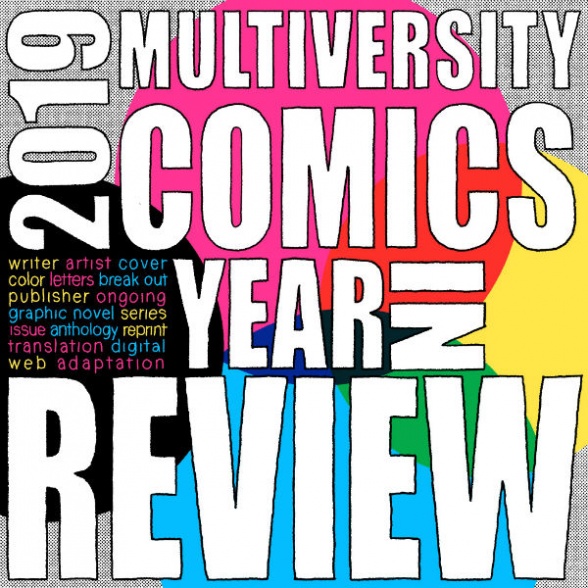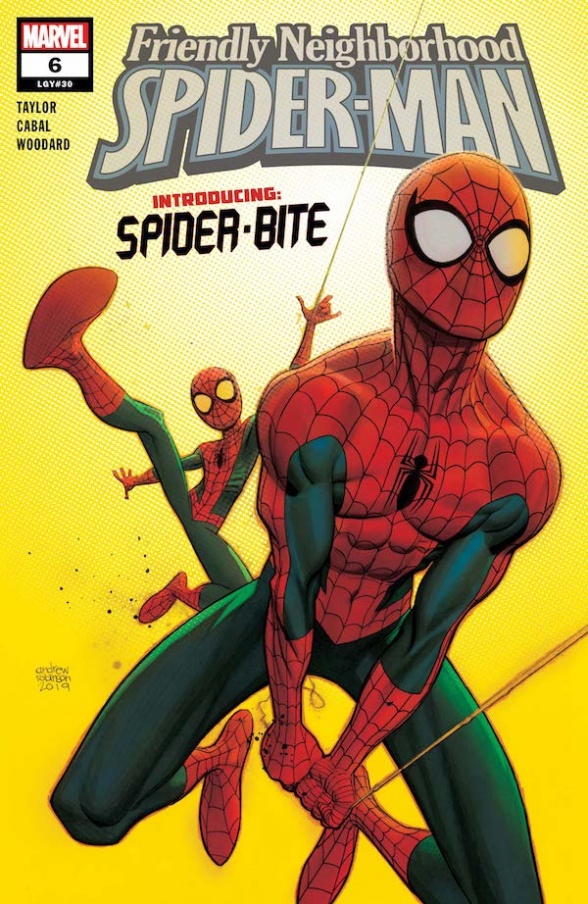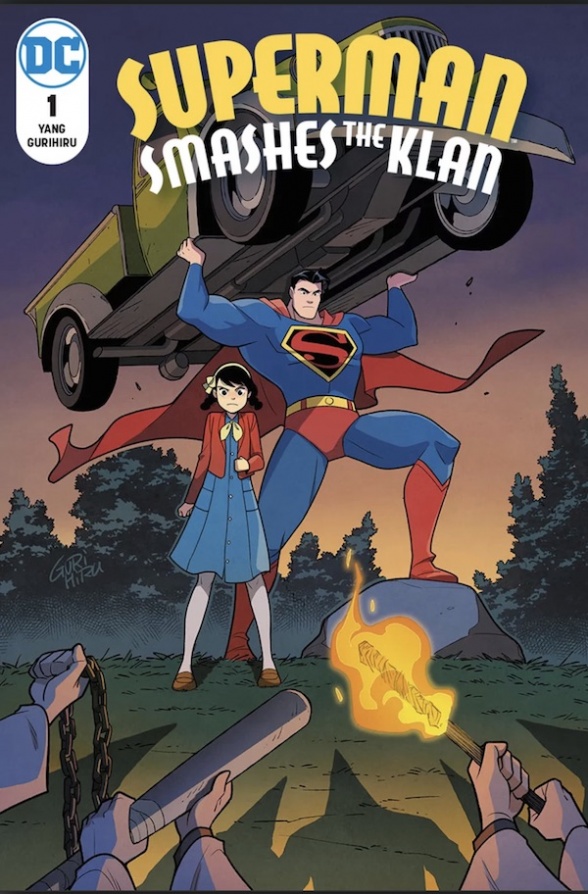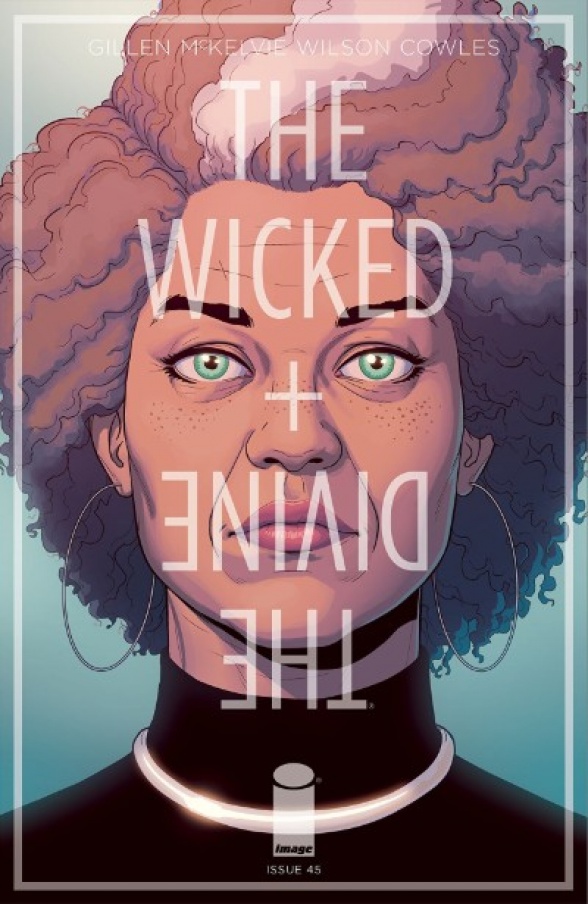
Every comic is someone’s first comic. That’s a cliche, but there’s a lot if truth in it, and because of that, it is important that every comic has something for new and old to hold onto. The issues that we selected represent the starts of books, the ends of long-ongoings, and those special issues that fall somewhere in between. We think all of these are exemplary examples of what single issue comics can be.

5. The White Trees #1
If you had told me a year ago that one of my favorite comics of 2019 would be a queer fantasy comic from Chip Zdarsky, Kris Anka, Matt Wilson, and Aditya Bidikar… well, I probably would’ve agreed and said something like “Yeah, that checks out.”. Seriously, this is a comic from creators that are all at the top of their games, and it still exceeded my expectations.
While there’s a rich backdrop of a raging war, complex lore, and compelling histories, I love “The White Trees” #1 because it doesn’t spend its time setting up all of that. The creators focus instead on delivering a story that’s entirely personal and completely relatable. At its core, this is the story of three older men who are out to rescue their missing children. What makes it even more compelling is that each of them has complex, dark histories that tend to present themselves during the course of the issue and make things especially interesting.
Of course, this is all brought lovingly to life from the art team. Kris Anka not only did a really great job at reminding me how bisexual I am but also spends time to make a stylish, yet intricate fantasy world replete with its own unique locals and architecture. Matt Wilson gives us some sparkling, beautiful royal palettes that range from vibrant to appropriately muted, and Bidikar does some super fun lettering work, especially with the brush stroke-esque sound effects that felt authentic. This issue is jam-packed with content and deserves your attention. – Rowan Grover

4 (tie). Friendly Neighborhood Spider-Man #6
How many times have you ever cried with a comic? Well, in my case, too many to count, but this year, the one that left a mark on me was this one. After we had TWO issues from Spidey in 2018’s list (“Peter Parker: The Spectacular Spider-Man” #310 & “Amazing Spider-Man” #801), this year the honor goes to Tom Taylor, Juan Cabal, Nolan Woodard & Federico Blee and Travis Lanham. Every time I’ve re-read “Friendly Neighborhood Spider-Man” #6 since it came out, I have cried, I have fallen in love with Spider-Man a little bit more and I have shouted “fucking Tom Taylor, man”, every single time.
This is how you do comics in this era. I remember when I read this issue’s solicit and saw it’s gorgeous, dynamic and fun cover from Andrew C. Robinson, I was seriously intrigued by what it told me, I mean, they couldn’t possibly really be adding a new legacy character for the most important hero of the company, right? I mean, we have an entire spider-verse of spider-related people. And then it hit me, hard.
This issue told us the story of Spider-Bite and his partner in a heartfelt story before bedtime. It had everything you could ask for, from subverting the classic imagery of Spider-Man under something heavy from “Amazing” #33, to a gorgeously done sixty-page(!) spread. Taylor, with the help of the art team, attempts to answer the most important story any comic professional could ask: why is Spider-Man so meaningful to so much people? And they triumph: He’s the heart of the city, he inspires people both in the fictionalized Marvel universe and in the real world.
People do what they do sometimes, like making mistakes, not because they don’t want to go to sleep, but because sometimes, people don’t know if they are going to wake up, that’s why heroes are so damn important, they don’t know if they are going to go back home, and they still fight every time.
“You’ll grow. –I Hope So.” – Ramon Piña

4 (tie). Superman Smashes the Klan #1
Continued below“Superman Smashes the Klan” is the sort of Superman story that only Gene Luen Yang can tell and the best answer you can give to someone who doesn’t understand the importance of elevating the voices of creators from diverse backgrounds. Anybody can throw together a team book about people from different backgrounds. Hell, they may even do a great job with it. But only a Chinese creator could so expertly craft a story like this, about a family of Chinese immigrants and not only have their personalities feel specific to their cultural background, but then authentically present to us their unique triumphs and struggles with living in America.
One of “Superman Smashes the Klan’s” keenest bits of racial examination (of which there are many) comes when Dr. Lee, the patriarch of the Chinese family the book is centered around, forcefully declines the help of a black man, before realizing that he’s a police officer. In the hands of a creator from a non-Chinese background, this could easily feel like a self-serving sequence assuring the reader: “see, everyone is a little racist sometimes.” In the hands of a Chinese creator, this segment feels more like something a young Gene could have witnessed first-hand from an adult figure in his life. It comes off as a reflection of something more nuanced and potentially autobiographical, than a plot point with an ulterior motive. All of this is to say that the book knocks its thematic concerns out of the park and that’s without even talking about how perfectly this series understands who Superman is.
By setting the comic in the 1940’s, not only do Yang and Gurihiru get to utilize the specific imagery and racial context of the time period, but they also get to use a Superman who acts as more of an ideal symbol of Americana, than one that is potentially weighed down by decades of dense lore. This Superman leaps tall buildings, instead of flying. He isn’t familiar with Kryptonite on a molecular level just yet. And he stands for something overtly political, which works extremely well in 1946, but also demonstrates a fearlessness from the creative team at the end of our current decade, where a very vocal (hopefully) minority of readers would rather not think about this.
Employing Gurihiru on art is another bold choice for a publisher that could have easily stuck an artist on this book whose style itself reflected a more classic DC Comics Golden-Age flavor. By using Japanese artists instead, “Superman Smashes the Klan” still gets its period feel right, but also touts more creators that might share some of the thematic stakes with the writer. They nail any and all artistic challenges the book presents on a technical level, and create a certain kind of crossover appeal aesthetically for a younger audience who is perhaps already comfortable with consuming something that looks like manga. “Superman Smashes the Klan” #1 is a great issue on its own, but when you consider that it also represents DC Comics hiring a creative team entirely from Asian backgrounds (including the letterer, Janice Chiang!), it also represents a major publisher putting its money where its mouth is for once. – Vince Ostrowski

3. The Wicked + The Divine #45
“It’s going to be okay,” Kieron Gillen tells us. Over more than fifty issues, we were given plenty of reasons to not believe him. In that time “The Wicked + The Divine” became the book for me that showed what comics were capable of. You know the book you suggest to your non-comics reading friends when they ask for a recommendation. The “Watchmen”/“Sandman”/“Y The Last Man” first step into a larger world. How could a book like that end? Could it land the ending? Could the five years of comics end in a way that would leave us satisfied?
Issue 44 left us at the end of the actual plot. Ending with artist Jamie McKelvie and colorist Matthew Wilson masterfully updating/remixing/foreshadowing the covers of issues #1, #18, and #45 for where we are now. The past year and a half of story have sent Laura through the ringer. She has grown and changed just like the reader hopefully has over that time. Best single issues in 2019 don’t exist in a void, they are part of the run. What was left for Laura’s story? Denouement?
Continued belowOver the years reading this comic month to month, we’ve come to know and love/hate these characters. This is one reason this is a standout single issue. The time and serialized nature of the storytelling ingrained the book into our lives. Just like Laura and the other characters having to live without Cassandra in their lives, the readers have to live without “The Wicked + The Divine.” It’s a funeral for the series.
So many moments in this issue hit me like an emotional freight train. Gillen’s writing throughout the series connected me to the characters. Despite living through fantastical experiences he made them feel real. I can’t think of another single issue this year that brought me to tears. Sayid (née Inanna) telling Laura they think of Baal “Every time it rains.” Umar (née Dionysus) agreeing with Laura that it seems like people never really die and then replying “But they do.” Aruna (née Tara) and her new body singing. Cassandra getting the final word at her service. Finally, Laura talking directly to the reader. The future is a blank page. Not only did Team WicDiv nail the ending on one of the most acclaimed comics of the decade, they did it in one of the best single issues of the year.
For a book with mortality as a major theme, you’d think a funeral would feel a bit on the nose. But, things rarely turn out like you expect them to in “The Wicked + The Divine.” McKelvie again shows why he is one of the best working in the medium today by effortlessly giving us these characters forty years later. McKelvie’s faces convey just as much emotion and story as any line of dialogue. Over the course of the issue we come to understand how the last forty years has aged and changed everyone. We see that time has given some of them the chance to become more true to themselves. – Matthew Vincenty

2. Giant Days #51
Given the quality of the final year of “Giant Days,” it’s no surprise to see it land on this list. I was kind of expecting “Giant Days” #54, just because it’s the easy choice what with it being the final issue of the ongoing series an’ all, but #51 was the one I was really hoping for. It’s the best issue in the series’ run and one of the most moving comics I’ve ever read.
When I got to the end of “Giant Days” #50, I was genuinely dreading #51. Reading this series feels less like reading about characters in a book and more like hanging out with friends, and I didn’t want to see the pain of a death in the family inflicted on McGraw. And yet, the issue was nothing like I expected. I laughed a lot, which is pretty standard for “Giant Days” under normal circumstances, but in #51 the laughing caught me by surprise. I guess I expected the comedy of the series to play second fiddle for a bit, but no, it’s as prominent as it ever was… and it never undermines the emotional stakes. Rather, it heightens them.
John Allison and Max Sarin explore such a wide range of emotions in so few pages, you’d expect an atonal mess, yet “Giant Days” #51 feels delicately controlled and cohesive. Most importantly, that journey is taking us somewhere. We go through so many other emotions before we get to McGraw simply crying because his dad is dead, that when we get there, it’s cathartic. They transformed a moment I’d been dreading into something I needed. It’s such a powerfully freeing moment.
And somehow, Allison and Sarin had me laughing and crying at the same time. These people are sorcerers, I swear. This is “Giant Days” at its absolute best. – Mark Tweedale

1. House of X #2
Ah, the retcon, that most subtle and elusive of comic storytelling tools. Retcons are necessary when you’re dealing with a near century of the story, but when executed properly they go from being an important convention to an art in and of themselves. That’s part of the reason why “House of X” #2 hit so hard. By the end of the first page, a character we’ve known since the ’70s is revealed to be a liar, a mastermind, and far more complicated then the appeared to be.
That’s not the only reason the Multiversity team wen crazy for “House of X” #2. From the moment Jonathan Hickman was announced as the new mind behind “X-Men” books, we knew to expect data pages, non-chronological storytelling, and juicy twists. This was the first issue that delivered and it was like an electric shock. The first time you read it, you understand that you can no longer believe your eyes- any story beat could be happening in any alternate universe, and the one you thought you knew was actually hiding dark secrets. But it doesn’t end there. The issues traces ten lives of a woman with the ability to resurrect to the moment of her birth… but it skips the sixth life entirely. Or does it? That sort of magic trick is a key tool Hickman uses to keep readers guessing, and we did. I haven’t been part of such an enthusiastic guessing game since Lost was on the air.
But OK, it’s twisty, but that’s not the main ingredient to a good comic. You need good art and words for that. Fortunately, “House of X” delivers the goods. Pepe Larraz and Marte Gracia draw a good comic, but they have the added challenge of showing change in an ageless protagonist. When Moira goes through a physical transformation in life number nine, she needs to project the wisdom she’s accumulated on her lifetimes of experience, and she does. And Hickman’s writing has rarely been better, combining his high concept sci-fi with a lyrical, almost poetic style. It reads like Frank Herbert or Isaac Asimov. It looks like a modern action adventure comic. But really, it looks and reads like no comic issue ever has, and is indisputably an instant classic. – Jake Hill






